Grey Crowned Cranes
Summary
GREY CROWNED CRANE Balearica regulorum regulorum
Conservation Status: Red Data Book of Birds of South Africa, Lesotho and Swaziland: Endangered. IUCN: EN; Cites Appendix I
Identification: Large 1.0 – 1.1 m, 3 – kg. Forehead and crown black and velvety. Crest of long vane-less feathers. Bear white face patch. Body grey, wings white edged in black and brown
South African Population: 3,000 - 4,000 adults
Key Habitats: Wetlands surrounded by natural grassland.
Main Threats: Habitat loss, poisoning, power-line collisions, burning of wetlands, chicks captured from the wild.
CONSERVATION: Landowner participation in management , responsible use of agri-chemicals
Identification
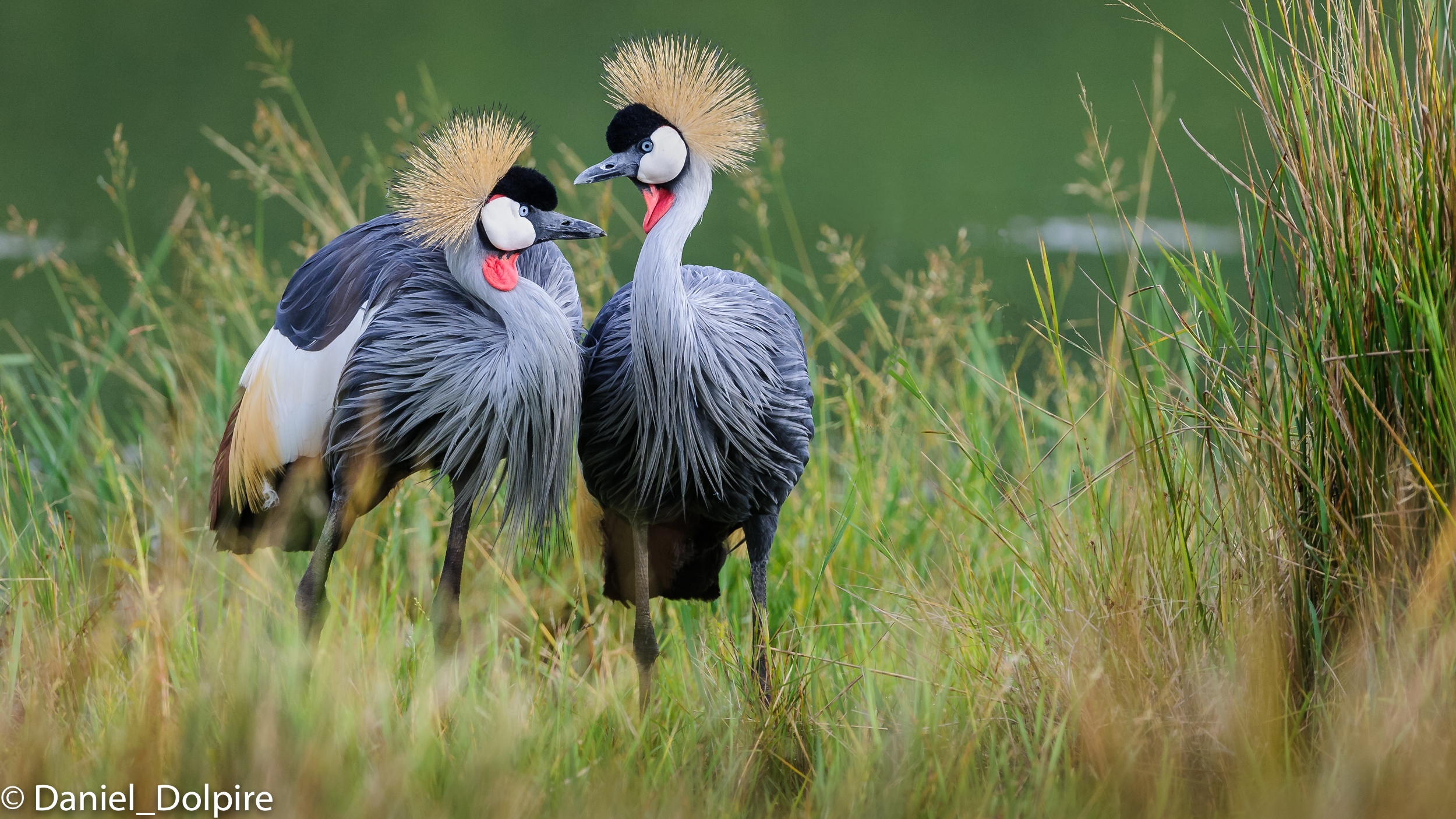
- +/- 1 m, 3-4 kg, Males slightly larger than females, but sexes alike in plumage.
- Spiky straw coloured crest, tipped with black.
- Dark grey to slate body, lighter grey neck.
- Distinctive large white wing patches, edged in black, rust brown and yellow (straw colour).
- Head mainly black with white cheeks and red wattles.
- Iris white to pale grey.
- Bill, legs and feet black.
- Cheeks bare and white.
Voice: Characteristic 2 syllabled trumpeting ma-Hem
Conservation
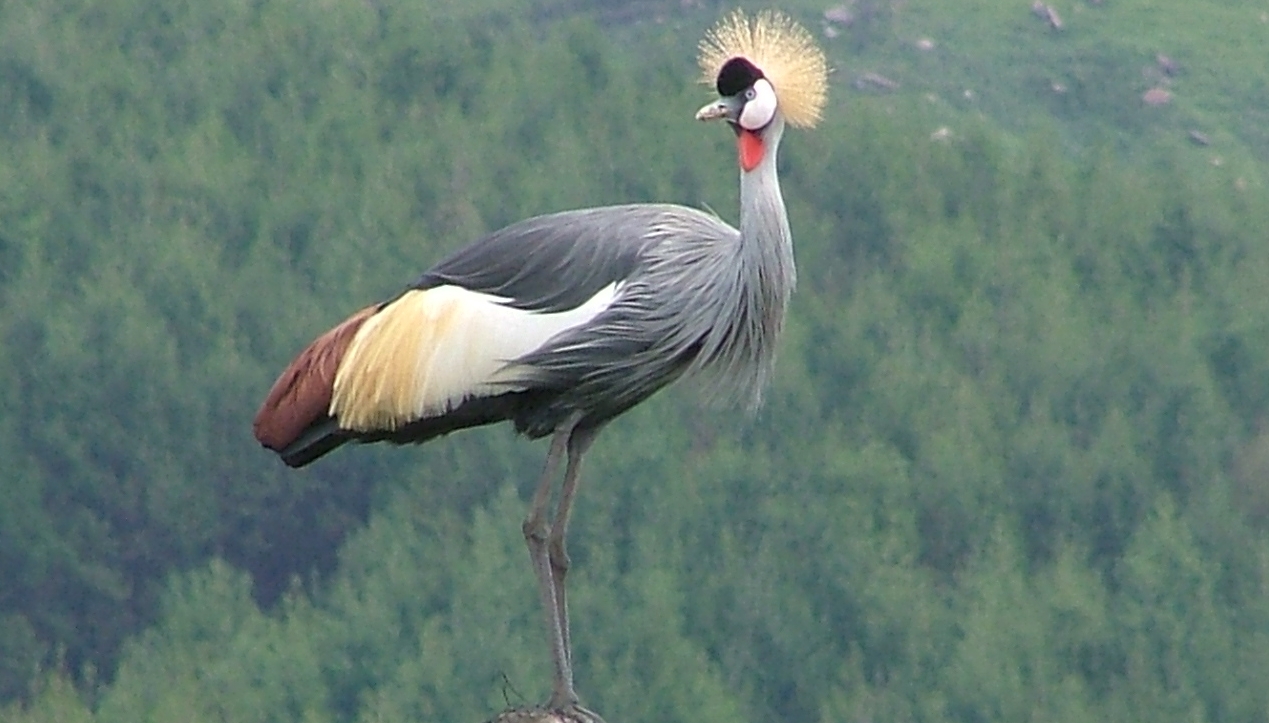
The Grey Crowned Crane nests and forages outside of protected areas, with the overriding conservation challenge being the development of sustainable management alternatives for their co-existence within humans. Through increased awareness and environmental education, community-based habitat (wetland and grassland) conservation programmes need to be developed (e.g. the Wakkerstroom Natural Heritage Association and the EWT Crane Custodian Programme), implementing management recommendations allowing cranes to co-exist in agricultural / human utilized regions. Solutions need to be provided to landowners experiencing crop / animal feed damage by cranes, through methods of preventing cranes eating the crops or establishing crane feeding restaurants during periods of crop sensitivity. Powerline incidents need to be identified and mitigated with standard techniques devised by Eskom. In certain areas, e.g. the Transkei, the cultural significance of the Grey Crowned Crane has afforded it a level of local protection, while general legal protection needs to be strengthened to restrict trade and protect cranes from being removed from the wild.
PROTECTED AREAS AND IBA’s
Steenkampsberg plateau, Chrissie pans, proposed Grassland Biosphere Reserve, Golden Gate Highlands and Qwaqwa National Parks, Chelmsford Nature Reserve, Spioenkop Nature Reserve, KwaZulu-Natal Drakensberg Park, Umvoti Vlei, Hlatikulu Nature Reserve, Midmar Nature Reserve, KwaZulu-Natal Mistbelt grasslands, Franklin Vlei, Penny Park, Oribi Gorge Nature Reserve and Vernon Crookes Nature Reserve.
Distribution
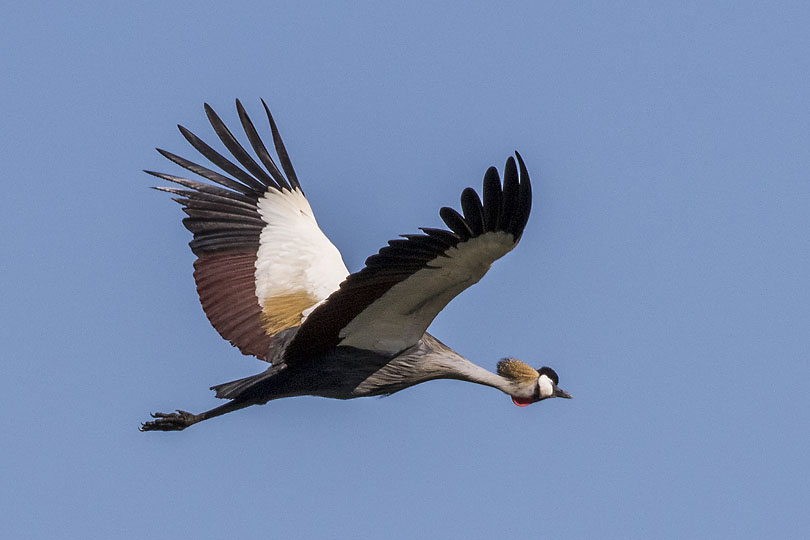
The Grey Crowned Crane is globally restricted to Africa, with its distribution not having changed much over the last century. The South African population, along with the population in Zimbabwe, Botswana, Mozambique, Namibia, and Zambia make up the smaller of the two subspecies, the South African subspecies (Balearica regulorum regulorum). Within South Africa, the Grey Crowned Crane is restricted to the moist eastern, higher-rainfall areas, from the Eastern Cape throughout the western parts of KwaZulu-Natal and north-eastern Free State, into the south-eastern areas of Mpumalanga. This species is most abundant in the higher altitudes of the north Eastern Cape/East Griqualand, KwaZulu-Natal midlands, and from Wakkerstroom to the north-east Free State. In the Free State, its breeding range has contracted to the north-east, while it no longer breeds in the Northern West Province.
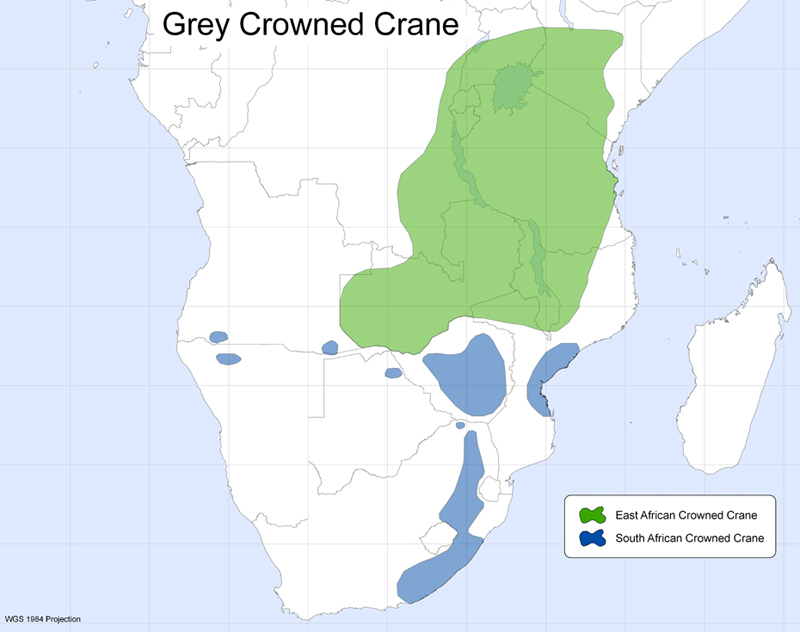
<- African Range of Grey Crowned Crane Populations
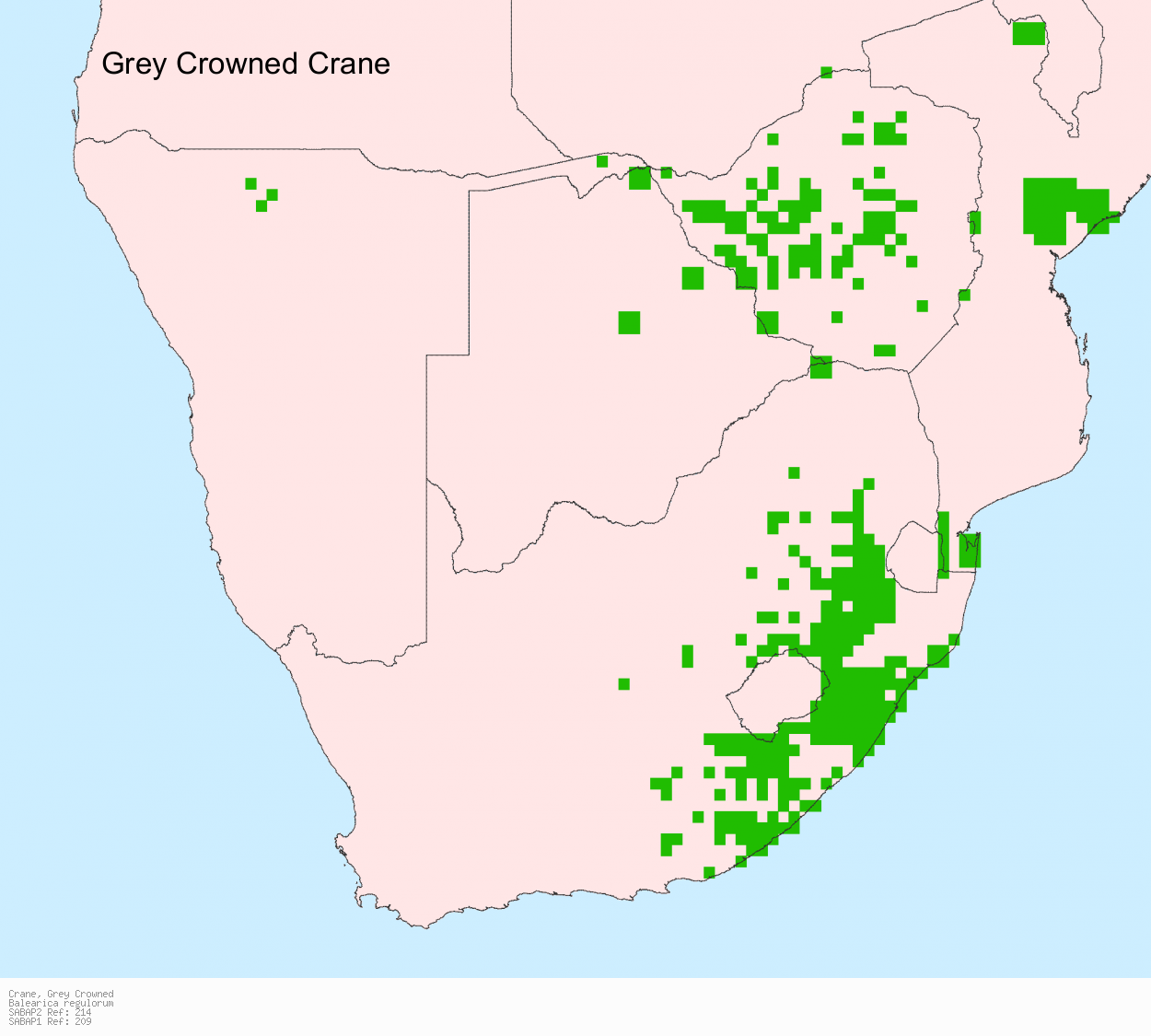
Ecology

Grey-crowned cranes are, in common with other cranes, monogamous and appear to mate for life. During courtship they perform nuptial dances in which both birds participate. The display includes various bobbing and bowing actions as well as jumps. Either the male or the female can initiate the dance. It can begin in many different ways; the pair may be walking together nor not. The dance begins with a series of calls during which the gular sac is inflated. After which they both bob their heads, then spread their wings and begin a series of jumps. Either partner may call the display to a halt. (Johnsgard, 1983; Walkinshaw, 1973).
Grey Crowned Cranes require mixed wetland-grassland habitats. They typically nest within or on the edges of permanent or temporary marshes / wetlands (utilizing smaller wetlands than Wattled Cranes). They may also nest in well-vegetated farm dams, where they make their nests among tall, often reedy, wetland vegetation, often of a height so that the nest is sufficiently concealed from terrestrial predators. The breeding season of this species varies depending on the duration and intensity of local dry and wet seasons. In South Africa, the Grey Crowned Crane is a summer breeder, with a peak in egg laying around November / December.
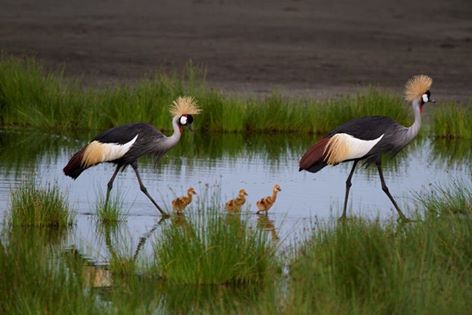
Clutch size can vary from 2 to 4 eggs which is larger than other cranes that usually have a clutch size of 1 to 2 eggs. Newly laid eggs are a light blue. The eggs have an incubation period of 28 to 30 days. About 12 hours after hatching they are capable of swimming and float like little cork balls. They begin eating after 24 hours. By the second day of hatching they are able to wander with their parents in search for food and they return to the nest night for brooding.
After the chicks hatch the family group does not forage in the savanna but instead keeps to the marshland where the tall grass can provide maximum coverage. Chicks fledge between 56-100 days after hatching. The juveniles will then join a flock containing other juveniles. Juveniles reach reproductive maturity at around 3 years old. (Johnsgard, 1983; Walkinshaw, 1964; Walkinshaw, 1973;del Hoyo, et al., 1996
Their preferred foraging habitat consists of expanses of short to medium height open grasslands adjacent to wetlands where they feed on grass seeds, insects and other invertebrates. Grey Crowned Cranes also use agricultural lands extensively in which to forage, including pastures, irrigated areas, fallow fields, newly planted cereal crops and harvested fields where they feed on harvest leftovers. The Grey Crowned Crane’s generalist feeding strategy has allowed this species to adapt to human settlement and can be found most often in man-modified environments. Interestingly, the crowned crane is the most primitive of the living Gruidae. Primitive species of crowned cranes date back in the fossil record to the Eocene period (34 to 55 million years BME). Archaeologists discovered that at least eleven species of crowned cranes once existed in Europe and North America. Because crowned cranes are not cold hardy, it is believed they died out in these areas as the earth cooled, and only survived in warmer Africa.
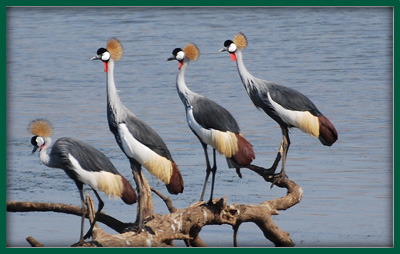
Population
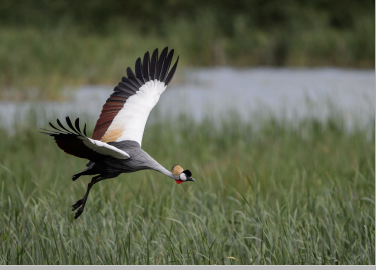
The Grey Crowned Crane is the most wide spread and culturally significant of the African cranes. The total African population has declined significantly over the last four decades, having abandoned certain areas of its former range. Its global population is estimated to be approximately 30,000 individuals, with the majority (18,000) being represented by the east African subspecies (Balearica regulorum gibbericeps).

A 2015 KZN annual crane survey put the number of Grey Crowned Cranes in the KZN area at approximately 3,000 . Population numbers in other areas of South Africa are less well documented, however it is estimated that there are c. 1,000 birds in the Eastern Cape, and about 350 in the north-east Free State / southern Mpumalanga region.
The South African population experienced a 55 % decline during the 1980/90’s, but in KZN it has recovered from under 2,000 to approximately 3,000 in the period 2000 to 2014. It is believed that this recovery is due to an increased awareness of the plight of cranes by farmers and their involvement in conservation measures.
Threats

Although this species remains abundant over much of its range, it faces widespread degradation of its historic breeding and feeding habitats. This has been caused by the alteration of habitats as intensive farming drains and dams wetlands and replaces grasslands with mono-cultures of crops and timber plantations. Despite this, the birds have adapted well to the intensified commercial agricultural practices and are often seen feeding in agricultural drylands throughout the year.
However, where cranes occur in large numbers in agricultural crops they are threatened by both accidental and deliberate poisoning, through the irresponsible application of agrichemicals. Where crop damage by cranes has been reported, incidents of shooting and intentional poisoning has increased.


As is the case with all large birds, power-lines pose a collision threat to young, inexperienced cranes as well as adult birds in misty low light conditions, while adult birds often get electrocuted on transformer boxes in attempting to roost on these structures. Grey Crowned Crane are very vulnerable to the removal / catching of young chicks from the wild prior to fledging, to be eaten, sold, or kept as pets. Many young chicks are also killed by domestic dogs.
